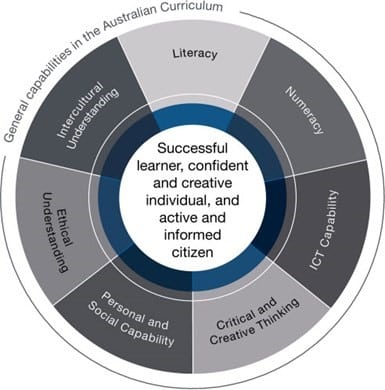Years 7-10 curriculum in Queensland for home economics-related subjects
Years 7-10 curriculum
In Queensland, Home Economics is taught under various banners, at the discretion of each school’s leadership. For example, it may be taught as one or a combination of: Home Economics; Food Technology; Food Studies; Food and Nutrition; Textiles Studies; Textiles and Fashion; Fashion Studies; Design; Design Studies; Early Childhood studies; and Hospitality.
At Years 7/10, the curriculum is based on the Australian Curriculum, developed by the Australian Curriculum, Assessment and Reporting Authority (ACARA). Home economics-related subjects, such as those suggested above, draw on two learning areas from the Australian Curriculum: Design and Technologies; and Health and Physical Education. The links to ACARA that follow provide further details. The Australian Curriculum also identifies the general capabilities that should be embedded into each of the learning areas, as well as cross-curriculum priorities (see explanations under ACARA). In addition, the Queensland Curriculum and Assessment Authority (QCAA) provides curriculum and assessment advice and resources for the Australian Curriculum learning areas (see links for QCAA that follow).
Australian Curriculum, Assessment and Reporting Authority
The Australian Curriculum, Assessment and Reporting Authority (ACARA) is the independent authority that developed the Australian Curriculum, a national curriculum for students from Foundation to Year 10. It was endorsed in September 2015, with a view to providing teachers, parents, students and members of the community with a clear understanding of what students should learn, regardless of where they live or what school they attend.
Home economics
The learning areas most relevant to Home Economics in Years 7–10 are:
The ACARA website shows how these two learning areas can be connected in its Australian Curriculum Connection Food and wellbeing, which provides a framework for all young Australians to understand and value the importance of good nutrition for health and wellbeing both across learning areas and specifically within the Technologies learning area as a technologies context in core learning across Foundation to Year 8 and as additional learning opportunities offered by states and territories in Years 9–10. The food and wellbeing connection is presented in bands of schooling. In Foundation—Year 6, the connection is described as nutrition, health and wellbeing. In Years 7—10, it is described as home economics.
General capabilities

Cross-curriculum priorities
In the Australian Curriculum, three cross-curriculum priorities provide national, regional and global dimensions that enrich the curriculum through development of considered and focused content that fits naturally within learning areas. They enable the delivery of learning-area content at the same time as developing knowledge, understanding and skills relating to:
- Aboriginal and Torres Strait Islander histories and cultures
- Asia and Australia’s engagement with Asia
- Sustainability
Queensland Curriculum and Assessment Authority (QCAA)
For Years 7/10, the QCAA site provides curriculum and assessment advice and resources for the Australian Curriculum as it pertains to Home Economics—that is, in relation to Design and Technologies, and to Health and Physical Education. Of particular use in the Assessment section are documents on making judgements about student work, and for both Years 7/8 and Years 9/10, standard elaborations that describe what A, B, C, D and E standards look like for the relevant knowledge, processes and skil
